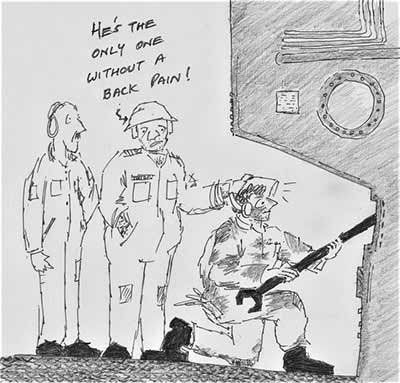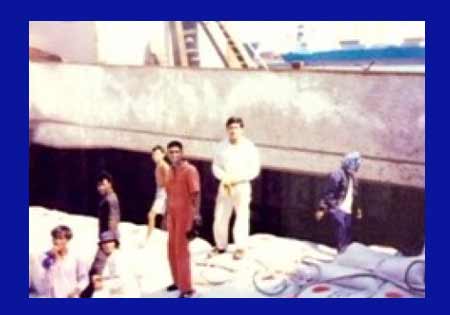My first experience with back-pain started when I was a Second Officer on a break-bulk ship. We had loaded refined wheat flour in bags from Italy to Yemen.
At Aden, with a tenth of the cargo remaining to be discharged, we found bags with mold in them. The affected bags had become green on the outside and hard to touch. The consignees would not accept the cargo and the stevedores stopped working.
To reduce the quantity of damaged cargo, the Captain ordered us to segregate the cargo- good from bad, so that the still intact ones could be discharged by the stevedores. So, our crew, me included had to manually remove the damaged bags. I was in my early twenties so I was working away furiously with the team. Even when others would take a break, I would continue- kind of ‘showing-off’ my youthful strength. Little did I know that this would instead be a mistake which would cause me troubles for many years to come.
At night, I got up from my sleep to get a glass of water. Just as I reached for the glass by my bedside, a searing pain shot up from my lower back. It was so intense that I believe I passed out. In the morning, I woke up on the floor and my back hurt like hell. I could not even make it to the dining salon. It took me two days of complete rest and multiple doses of painkillers for me to keep watch. Not only was I off the cargo removal duty, fearing that other crew would also end up with back pain, the Captain had engaged trained stevedores to finish the rest of the job.
For several years after that, even as Chief Officer and Master, the pain surfaced every now and then, though thankfully not to that extent. It would appear after I had inspected a few double-bottom tanks with my back bent for several hours. I soon started wearing a back-support strap when I expected to go up and down cargo tank in the drydock.
Surprisingly, in my first few years working in the shore office, I still had episodes when the back pain was too much and I worked from home instead. But these were different. I’m right handed so the stiffness usually was on the right side of my torso. Besides the physical pain, back pain can make us irritable, and we’re not at our best as a leader.
Over the last few years, I’ve researched the condition in depth and have taken preventive steps. It has worked and I will share these with you. I haven’t taken a day off over the last five years because of back pain, even though I still perform weighted deadlifts, squats and back-rows in the gym.

First, a few facts:
1. Worldwide, back pain is the single leading cause of disability and one of the most common reasons for missed work; it is estimated that two work days are lost per year for every full-time worker.
2. Experts estimate that up to 80% of the population will experience back pain at some time in their lives.
3. Back injuries (disc herniation and lumbosacral strain) are the number one reason for permanent disability claims among seafarers in the Philippines.
4. Low-back pain costs Americans at least $50 billion in health care costs each year; add in lost wages and decreased productivity and that figure easily rises to more than $100 billion.
5. Back pain is the third most common reason for visits to the doctor’s office, behind skin disorders and osteoarthritis/joint disorders.
But back pain need not be dangerous:
6. Most cases of back pain are mechanical or non-organic—meaning they are not caused by serious conditions, such as inflammatory arthritis, infection, fracture or cancer.
7. Most people with low back pain recover, however reoccurrence is common and for small percentage of people the condition will become chronic and disabling.
Causes of back pain:
Back pain can be caused by disease of the internal organs, such as kidney stones, kidney infections, blood clots, or bone loss. However, the most common back pains are sprained muscle (like I did) or the serious slipped disc- due to accidents and sports injuries. In addition, poor posture, obesity, and psychological stress can cause or complicate back pain.
What can you do about it?
I’m not going to give medical advice as this is for you to consult your physician and chiropractor. Do it without delay.
I can however suggest some preventive actions to avoid work related injury like I did.
1. I should not have lifted those bags by bending my back. Instead I should have lifted by exerting my legs. It would have helped if I had kept the bag close to my body and had I not twisted my torso to throw the bag. Better still, I should have taken on a partner for lifting those bags. In my later years, I would repeat this caution every morning during our tool box meetings.
2. Warm up and stretch before you start your work- whether on ship, or in an office.
3. Maintain proper posture. Like my mother used to say “don’t slouch”.
4. Whether you’re standing during the navigational watch for hours, or sitting in front of the computer, or working in an uncomfortable position. Take a break every hour. Breathe deeply and stretch to minimise back fatigue.
5. Sleep on a mattress of medium firmness to minimize any curve in your spine. If you’re a ship operator, keep this in mind when ordering mattresses for your ships.
6. Smoking impairs blood flow, resulting in oxygen and nutrient deprivation to spinal tissues.
7. Wear comfortable, low-heeled shoes.
Be a leader with a backbone. A strong backbone.
++++++
Many thanks to Dr.Rajesh Botchu for his expert medical inputs for this article. He is a Consultant Musculoskeletal Radiologist and Orthopaedic Surgeon. More about what he does at www.mskradiology4u.co.uk and www.bonesradiologist.co.uk
References:
- An educational video on safe lifting for the maritime industry
- A video on simple back flexibility exercises. In yoga, they say that “you’re only as old as your spine”
- Hoy D, March L, Brooks P, et al The global burden of low back pain: estimates from the Global Burden of Disease 2010 study Annals of the Rheumatic Diseases Published Online First: 24 March 2014. doi: 10.1136/annrheumdis-2013-204428
- Vallfors B. Acute, Subacute and Chronic Low Back Pain: Clinical Symptoms, Absenteeism and Working Environment. Scan J Rehab Med Suppl1985; 11: 1-98.
- Rubin Dl. Epidemiology and Risk Factors for Spine Pain. Neurol Clin. 2007; May;25(2):353-71.
- Hartvigsen J et al. Low Back Pain Series: What Low Back Pain Is and Why We Need to Pay Attention. Lancet, June 2018; Volume 391, Issue 10137; p2356-2367.
- Gard P&I Club, A crew claims statistical analysis, 2004.


